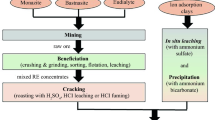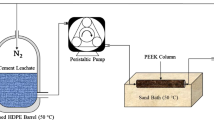Abstract
Several rare earth element (REE) mine projects around the world are currently at the feasibility stage. Unfortunately, few studies have evaluated the contamination potential of REE and their effects on the environment. In this project, the waste rocks from the carbonatites within the Montviel proterozoic alkaline intrusion (near Lebel-sur-Quévillon, Quebec, Canada) are assessed in this research. The mineralization is mainly constituted by light REE (LREE) fluorocarbonates (qaqarssukite-Ce, kukharenkoite-Ce), LREE carbonates (burbankite, Sr-Ba-Ca-REE, barytocalcite, strontianite, Ba-REE-carbonates), and phosphates (apatite, monazite). The gangue minerals are biotites, chlorite, albite, ankerite, siderite, and calcite. The SEM-EDS analyses show that (i) the majority of REE are associated with the fine fraction (< 106 μm), (ii) REE are mainly associated with carbonates, (iii) all analyzed minerals preferably contain LREE (La, Ce, Pr, Nd, Sm, Eu), (iv) the sum of LREE in each analyzed mineral varies between ~ 3 and 10 wt%, (v) the heavy REE (HREE) identified are Gd and Yb at < 0.4 wt%, and (vi) three groups of carbonate minerals were observed containing variable concentrations of Ca, Na, and F. Furthermore, the mineralogical composition of REE-bearing minerals, REE mobility, and REE speciation was investigated. The leachability and geochemical behavior of these REE-bearing mine wastes were tested using normalized kinetic testing (humidity cells). Leachate results displayed higher LREE concentrations, with decreasing shale-normalized patterns. Thermodynamical equilibrium calculations suggest that the precipitation of secondary REE minerals may control the REE mobility.











Similar content being viewed by others
References
Adam K, Kourtis A, Gazea B, Kontopoulos A (1997) Evaluation of static tests used to predict the potential for acid drainage generation at sulfide mine sites. Trans Instn Min Metall Sect A: Min Ind 106:A1–A8
Bau M (1999) Scavenging of dissolved yttrium and rare earths by precipitating iron oxyhydroxide: Experimental evidence for Ce oxidation, Y-Ho fractionation, and lanthanide tetrad effect. Geochim Cosmochim Acta 63:67–77. https://doi.org/10.1016/S0016-7037(99)00014-9
Benzaazoua M, Bussiére B, Dagenais AM, Archambault M (2004) Kinetic tests comparison and interpretation for prediction of the Joutel tailings acid generation potential. Environ Geol 46(8):1086–1101. https://doi.org/10.1007/s00254-004-1113-1
Bussière B (2007) Colloquium 2004: hydrogeotechnical properties of hard rock tailings from metal mines and emerging geoenvironmental disposal approaches. Can Geotech J 44(9):1019–1052. https://doi.org/10.1139/t07-040
David J, Dion C, Goutier J (2006) Datations U-Pb effectuées dans la Sous-province de l’Abitibi à la suite des travaux de 2004-2005. Ressources naturelles et Faune, RP 2006-04, Quebéc
Desharnais G, Duplessis C (2011) Montviel core zone REE mineral resource estimate technical report. Geomega Resources Inc Member of SGS group (SGS SA), Quebec
Edahbi M, Plante B, Bouzahzah H, Benzaazoua M (2015) Mineralogical and geochemical study of rare earth elements from a carbonatite deposit. Proceedings of the 13th SGA biennial meeting, Nancy, France
Gimeno Serrano MJ, Auqué Sanz LF, Nordstrom DK (2000) REE speciation in low-temperature acidic waters and the competitive effects of aluminum. Chem Geol 165(3-4):167–180. https://doi.org/10.1016/S0009-2541(99)00166-7
Gonzalez V, Vignati DAL, Leyval C, Giamberini L (2014) Environmental fate and ecotoxicity of lanthanides: are they a uniform group beyond chemistry? Environ Int 71:148–157. https://doi.org/10.1016/j.envint.2014.06.019
Goutier J (2006) Géologie de la région du lac au Goéland (32F/15). Ressources naturelles et Faune, Québec
Jaireth S, Hoatson DM, Miezitis Y (2014) Geological setting and resources of the major rare-earth-element deposits in Australia. Ore Geol Rev 62:72–128. https://doi.org/10.1016/j.oregeorev.2014.02.008
Janssen RPT, Verweij W (2003) Geochemistry of some rare earth elements in groundwater, Vierlingsbeek, The Netherlands. Water Res 37(6):1320–1350. https://doi.org/10.1016/S0043-1354(02)00492-X
Johannesson KH, Lyons WB, Yelken MA, Gaudette HE, Stetzenbach KJ (1996) Geochemistry of the rare-earth elements in hypersaline and dilute acidic natural terrestrial waters: complexation behavior and middle rare-earth element enrichments. Chem Geol 133(1-4):125–144. https://doi.org/10.1016/S0009-2541(96)00072-1
Kato Y, Fujinaga K, Nakamura K, Takaya Y, Kitamura K, Ohta J, Toda R, Nakashima T, Iwamori H (2011) Deep-sea mud in the Pacific Ocean as a potential resource for rare-earth elements. Nat Geosci 4(8):535–539. https://doi.org/10.1038/ngeo1185
Kwitko-Ribeiro R (2012) New sample preparation developments to minimize mineral segregation in process mineralogy. In: Proceedings of the 10th International Congress for Applied Mineralogy (ICAM). Springer, pp 411–417. https://doi.org/10.1007/978-3-642-27682-8_49
Lawrence R, Wang Y (1996) Determination of neutralization potential for acid rock drainage prediction. MEND project 1:38
Leybourne MI, Goodfellow WD, Boyle DR, Hall GM (2000) Rapid development of negative Ce anomalies in surface waters and contrasting REE patterns in groundwaters associated with Zn–Pb massive sulphide deposits. Appl Geochem 15(6):695–723. https://doi.org/10.1016/S0883-2927(99)00096-7
Lipin BR (1989) Geochemistry and mineralogy of rare earth elements. Rev Mineral 21
McLellan BC, Corder GD, Golev A, Ali SH (2014) Sustainability of the rare earths industry. Procedia Environ Sci 20:280–287. https://doi.org/10.1016/j.proenv.2014.03.035
Merkus HG (2009) Particle size measurements: fundamentals, practice, quality, vol 17. Springer Science & Business Media.
Bau M (1999) Scavenging of dissolved yttrium and rare earths by precipitating iron oxyhydroxide: experimental evidence for Ce oxidation, Y-Ho fractionation, and lanthanide tetrad effect. Geochimica et Cosmochimica Acta 63(1):67-77
Miekeley N, Coutinho de Jesus H, Porto da Silveira CL, Linsalata P, Morse R (1992) Rare-earth elements in groundwaters from the Osamu Utsumi mine and Morro do Ferro analogue study sites, Poços de Caldas, Brazil. J Geochem Explor 45(1-3):365–387. https://doi.org/10.1016/0375-6742(92)90131-Q
Nadeau O, Stevenson R, Jébrak M (2014) The Archean magmatic-hydrothermal system of Lac Shortt (Au-REE), Abitibi, Canada: insights from carbonate fingerprinting. Chem Geol 387:144–156. https://doi.org/10.1016/j.chemgeo.2014.08.021
Nadeau O, Cayer A, Pelletier M, Stevenson R, Jébrak M (2015) The Paleoproterozoic Montviel carbonatite-hosted REE–Nb deposit, Abitibi, Canada: geology, mineralogy, geochemistry and genesis. Ore Geol Rev 67:314–335. https://doi.org/10.1016/j.oregeorev.2014.12.017
Nadeau O, Stevenson R, Jébrak M (2016) Evolution of Montviel alkaline-carbonatite complex by coupled fractional crystallization, fluid mixing and metasomatism—part II: trace element and Sm–Nd isotope geochemistry of metasomatic rocks: implications for REE-Nb mineralization. Ore Geol Rev 72(Part 1):1163–1173. https://doi.org/10.1016/j.oregeorev.2015.09.021
Parkhurst DL, Appelo C (2013) Description of input and examples for PHREEQC version 3: a computer program for speciation, batch-reaction, one-dimensional transport, and inverse geochemical calculations. US Geol Surv
Plante B, Benzaazoua M, Bussière B (2010) Predicting geochemical behaviour of waste rock with low acid generating potential using laboratory kinetic tests. Mine Water Environ 30:2–21. https://doi.org/10.1007/s10230-010-0127-Z.
Plante B, Bussière B, Benzaazoua M (2012) Static tests response on 5 Canadian hard rock mine tailings with low net acid-generating potentials. J Geochem Explor 114:57–69. https://doi.org/10.1016/j.gexplo.2011.12.003.
Price WA (2009) Prediction manual for drainage chemistry from sulphidic geologic materials. MEND report 1:579
Prinčič T, Štukovnik P, Pejovnik S, De Schutter G, Bokan Bosiljkov V (2013) Observations on dedolomitization of carbonate concrete aggregates, implications for ACR and expansion. Cem Concr Res 54:151–160. https://doi.org/10.1016/j.cemconres.2013.09.005
Prudêncio MI, Valente T, Marques R, Braga MAS, Pamplona J (2015) Geochemistry of rare earth elements in a passive treatment system built for acid mine drainage remediation. Chemosphere 138:691–700. https://doi.org/10.1016/j.chemosphere.2015.07.064
Prudêncio MI, Valente T, Marques R, Braga MAS, Pamplona J (2017) Rare earth elements, iron and manganese in ochre-precipitates and wetland soils of a passive treatment system for acid mine drainage. Procedia Earth Planet Sci 17:932–935. https://doi.org/10.1016/j.proeps.2017.01.024
Purdy C (2014) The geochemical and mineralogical controls on the environmental mobility of rare earth elements from tailings, Nechalacho Deposit, Northwest Territories
Sapsford DJ, Bowell RJ, Geroni JN, Penman KM, Dey M (2012) Factors influencing the release rate of uranium, thorium, yttrium and rare earth elements from a low grade ore. Miner Eng 39:165–172. https://doi.org/10.1016/j.mineng.2012.08.002
Sneller FEC, Kalf FD, Weltje L, Wezel APV (2000) Maximum permissible concentrations and negligible concentrations for rare earth elements (REEs). Research for Man and Environnement, RIVM report 601501011. http://www.rivmnl/bibliotheek/rapporten/601501011html
Sobek AA (1978) Field and laboratory methods applicable to overburdens and minesoils. Industrial Environmental Research Laboratory, Office of Research and Development, US Environmental Protection Agency
Steinmann M, Stille P (2008) Controls on transport and fractionation of the rare earth elements in stream water of a mixed basaltic–granitic catchment basin (Massif Central, France). Chem Geol 254(1-2):1–18. https://doi.org/10.1016/j.chemgeo.2008.04.004
Stille P, Steinmann M, Pierret MC (2006) The impact of vegetation on fractionation of rare earth elements (REE) during water–rock interaction. J Geochem Explor 88:341–344. https://doi.org/10.1016/j.gexplo.2005.08.070.
Sun H, Zhao F, Zhang M, Li J (2011) Behavior of rare earth elements in acid coal mine drainage in Shanxi Province, China. Environ Earth Sci 67(1):205–213. https://doi.org/10.1007/s12665-011-1497-7
Valente TM, Antunes M, Braga AS, Prudêncio M, Marques R, Pamplona J (2012) Mineralogical attenuation for metallic remediation in a passive system for mine water treatment. Environ Earth Sci 66(1):39–54. https://doi.org/10.1007/s12665-011-1205-7
Verplanck PL, Nordstrom DK, Taylor HE, Kimball BA (2004) Rare earth element partitioning between hydrous ferric oxides and acid mine water during iron oxidation. Appl Geochem 19(8):1339–1354. https://doi.org/10.1016/j.apgeochem.2004.01.016
Villeneuve M, Bussière B, Benzaazoua M, Aubertin M, Monroy M (2003) The influence of kinetic test type on the geochemical response of low acid generating potential tailings. Proc Tailings Mine Waste 3:269–279
Villeneuve M, Bussière B, Benzaazoua M, Aubertin M (2009) Assessment of interpretation methods for kinetic tests performed on tailings having a low acid generating potential. Proceedings, Securing the Future and 8th ICARD, Skelleftea, Sweden
Wang L, Liang T (2014) Effects of exogenous rare earth elements on phosphorus adsorption and desorption in different types of soils. Chemosphere 103:148–155. https://doi.org/10.1016/j.chemosphere.2013.11.050
Yang XJ, Lin A, Li X-L, Wu Y, Zhou W, Chen Z (2013) China’s ion-adsorption rare earth resources, mining consequences and preservation. Environ Dev 8:131–136. https://doi.org/10.1016/j.envdev.2013.03.006
Yusoff ZM, Ngwenya BT, Parsons I (2013) Mobility and fractionation of REEs during deep weathering of geochemically contrasting granites in a tropical setting, Malaysia. Chem Geol 349–350:71–86. https://doi.org/10.1016/j.chemgeo.2013.04.016
Acknowledgements
The authors thank the URSTM staff for their support with laboratory work and NSERC/Geomega Resources for funding of this study.
Author information
Authors and Affiliations
Corresponding author
Additional information
Responsible editor: Philippe Garrigues
Rights and permissions
About this article
Cite this article
Edahbi, M., Plante, B., Benzaazoua, M. et al. Geochemistry of rare earth elements within waste rocks from the Montviel carbonatite deposit, Québec, Canada. Environ Sci Pollut Res 25, 10997–11010 (2018). https://doi.org/10.1007/s11356-018-1309-7
Received:
Accepted:
Published:
Issue Date:
DOI: https://doi.org/10.1007/s11356-018-1309-7




